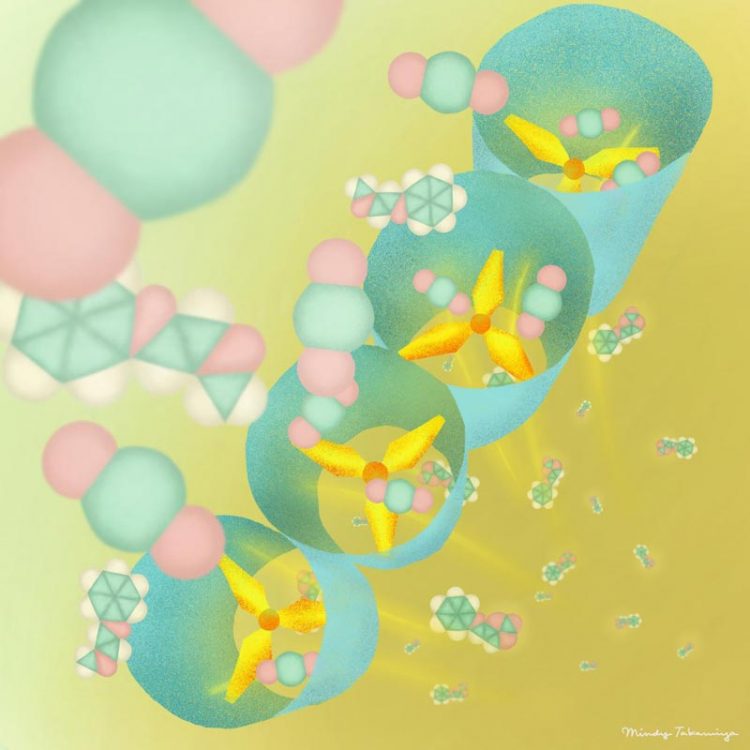New material captures carbon dioxide

This new porous coordination polymer has propeller-shaped molecular structures that enables selectively capturing CO2, and efficiently convert the CO2 into useful carbon materials. Illustration by Mindy Takamiya Usage Restrictions: CC BY 4.0 - Credit display required
A new material that can selectively capture carbon dioxide (CO2) molecules and efficiently convert them into useful organic materials has been developed by researchers at Kyoto University, along with colleagues at the University of Tokyo and Jiangsu Normal University in China. They describe the material in the journal Nature Communications.
Human consumption of fossil fuels has resulted in rising global CO2 emissions, leading to serious problems associated with global warming and climate change. One possible way to counteract this is to capture and sequester carbon from the atmosphere, but current methods are highly energy intensive. The low reactivity of CO2 makes it difficult to capture and convert it efficiently.
“We have successfully designed a porous material which has a high affinity towards CO2 molecules and can quickly and effectively convert it into useful organic materials,” says Ken-ichi Otake, Kyoto University materials chemist from the Institute for Integrated Cell-Material Sciences (iCeMS).
The material is a porous coordination polymer (PCP, also known as MOF; metal-organic framework), a framework consisting of zinc metal ions. The researchers tested their material using X-ray structural analysis and found that it can selectively capture only CO2 molecules with ten times more efficiency than other PCPs.
The material has an organic component with a propeller-like molecular structure, and as CO2 molecules approach the structure, they rotate and rearrange to permit C02 trapping, resulting in slight changes to the molecular channels within the PCP – this allows it to act as molecular sieve that can recognize molecules by size and shape. The PCP is also recyclable; the efficiency of the catalyst did not decrease even after 10 reaction cycles.
“One of the greenest approaches to carbon capture is to recycle the carbon dioxide into high-value chemicals, such as cyclic carbonates which can be used in petrochemicals and pharmaceuticals,” says Susumu Kitagawa, materials chemist at Kyoto University.
After capturing the carbon, the converted material can be used to make polyurethane, a material with a wide variety of applications including clothing, domestic appliances and packaging.
This work highlights the potential of porous coordination polymers for trapping carbon dioxide and converting into useful materials, opening up an avenue for future research into carbon capture materials.
###
DOI: 10.1038/s41467-019-12414-z
About Kyoto University's Institute for Integrated Cell-Material Sciences (iCeMS)
At iCeMS, our mission is to explore the secrets of life by creating compounds to control cells, and further down the road to create life-inspired materials that confront the myriad problems that afflict modern society. In only a decade, collaborative research at iCeMS has resulted in significant cutting-edge scientific discoveries, and the creation of over 1500 unique materials. We will keep running for the greater future of science.
https:/
For more information, contact
Mari Toyama/I. Mindy Takamiya
pe@mail2.adm.kyoto-u.ac.jp
Media Contact
More Information:
http://dx.doi.org/10.1038/s41467-019-12414-zAll latest news from the category: Materials Sciences
Materials management deals with the research, development, manufacturing and processing of raw and industrial materials. Key aspects here are biological and medical issues, which play an increasingly important role in this field.
innovations-report offers in-depth articles related to the development and application of materials and the structure and properties of new materials.
Newest articles

A ‘language’ for ML models to predict nanopore properties
A large number of 2D materials like graphene can have nanopores – small holes formed by missing atoms through which foreign substances can pass. The properties of these nanopores dictate many…

Clinically validated, wearable ultrasound patch
… for continuous blood pressure monitoring. A team of researchers at the University of California San Diego has developed a new and improved wearable ultrasound patch for continuous and noninvasive…

A new puzzle piece for string theory research
Dr. Ksenia Fedosova from the Cluster of Excellence Mathematics Münster, along with an international research team, has proven a conjecture in string theory that physicists had proposed regarding certain equations….



